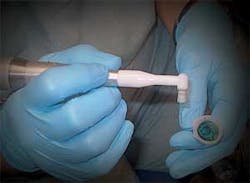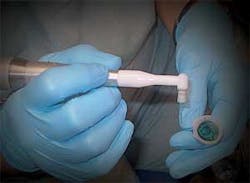To Polish or Not to Polish
Rethinking the concept of selective polishing
by Stephanie Wall, RDH, MSDH, MEd
For many years, the standard of care for the dental hygienist performing a prophylaxis included coronal polishing. It remained the standard until research discovered that polishing removed valuable enamel. At that time, the recommended standard of care shifted and the concept of “selective polishing” was established. The American Dental Hygienists' Association (ADHA) came on board with their position paper on polishing that stated the following:
- Polishing is viewed as a cosmetic procedure with little therapeutic value
- Thorough brushing and flossing can produce the same effect as polishing
- Continuous polishing can, over time, cause morphological changes by abrading tooth structure away
- Fluoride in the outer layers of enamel is removed through polishing
Their main conclusion was that “polishing should be performed only as needed and not be considered a routine procedure.” In other words, rather than polishing every tooth surface, the dental hygienist should evaluate which teeth require it and then polish only those tooth surfaces, paying particular attention to areas of exposed cementum and dentin and working around cosmetic restorations.
A couple of questions, though, come to mind. Was it appropriate for the ADHA to make a broad statement against polishing? Probably not, especially since part of the reason the concept was established was to address the dental hygiene scope of practice — keeping coronal polishing out of the hands of dental assistants, which hasn't entirely been successful. Nearly half the states have changed their practice acts to include coronal polishing by dental assistants who have had the proper training.
Additionally, at the time the paper was published, the ADHA was not representative of the majority of dental hygienists in the United States. Since that time, membership has increased.
Have dental hygienists, in general, adhered to the “selective polishing” concept? Probably not, since most dental hygienists include full mouth coronal polishing as an integral part of their prophylaxis procedure. This is the reality! It probably isn't what they were taught in dental hygiene school; however, it is what they do and, more importantly, patients expect it. If there is no polishing, the patient may feel shortchanged.
Is polishing all of the teeth always detrimental or can there be possible benefits, either to the patient or the tooth surface (or both)? In the past, many would say there was no real benefit to full mouth polishing. But in the practice of today's dental hygiene, is this still the case? Have circumstances changed since the establishment of the “selective polishing” concept? Is it time to rethink where the profession of dental hygiene stands regarding this issue? I believe it is to the benefit of the patient and the dental hygiene practitioner to take another look.
An added punch to prophy paste
Several prophy paste products available will ease the practicing dental hygienist into feeling comfortable with the polishing process, especially if they are true-blue “selective polishing” practitioners. The products include Enamel Pro™ prophy paste with ACP (Premier), Kolorz™ prophy paste with xylitol (Zenith Dental), Sparkle™ prophy paste with xylitol (Crosstex International), Proxyt® prophy paste with xylitol (Ivoclar Vivadent), and NUPRO® NuSolutions™ prophy paste with NovaMin® (Dentsply). Other prophy pastes are on the market too; however, the aforementioned offer ingredients other than or in addition to fluoride.
Enamel Pro with ACP is currently the only prophy paste available with the active ingredient of amorphous calcium phosphate (ACP). ACP is an inorganic compound made by combining the soluble salts of calcium sulfate and dipotassium phosphate. The technology requires a two-phase delivery system to keep the calcium and phosphorous components from reacting with each other before use. When they are mixed, they rapidly form amorphous calcium phosphate that can precipitate onto the tooth surface.
The precipitated ACP then can readily dissolve into the saliva and be available for tooth remineralization. However, ACP is highly soluble, so repeated attacks by an acidic environment will break down the product and wash it away. Clinical claims include improving tooth surface smoothness, thereby making it more difficult for bacterial adherence and growth, remineralization of acid erosion and abrasion, and effective removal of extrinsic stain.
The xylitol products currently available are Kolorz, Sparkle, and Proxyt. Pure xylitol is a white crystalline substance that looks and tastes like sugar. It is naturally found in many fruits and vegetables and produced in small amounts in the human body. It has a wide variety of uses and benefits, from improving the health of your teeth to maintaining upper respiratory health. It has been shown to reduce the risk of tooth decay with as little as 15 grams per day. It is safe for anyone and can be delivered through chewing gum, tablets or candy. It stimulates saliva production and can alleviate dry mouth. Most bacteria cannot metabolize xylitol, resulting in the reduction of acid and biofilm production in the mouth. Consider recommending xylitol products to your patients. There are many; most have a pleasant taste and they can have real benefits for oral health.
NUPRO® NUSolutions™ with NovaMin® is the newest Dentsply Professional prophy paste. It is currently the only product powered by NovaMin, delivering the triple benefit of tooth desensitization, tubule occlusion and stain removal. NovaMin has been available in other products and has only recently been introduced in the dental industry. NovaMin is made of a synthetic mineral containing sodium, calcium, phosphorous and silica, which are all elements found naturally in the body. When this product comes into contact with saliva or water, it rapidly releases sodium, calcium and phosphorous ions into the saliva and is available for remineralization of the tooth surface. Unlike other calcium phosphate technologies, the ions that are released by NovaMin are in the form of hydroxycarbonate apatite (HCA) directly, without the intermediate amorphous calcium phosphate (ACP) phase. These particles attach to the tooth surface and continue to release ions and remineralize the tooth surface after initial application. These particles have been shown in clinical studies to release ions and transform into HCA for up to two weeks. To date, there has been no other prophy paste product that can make this claim.
NovaMin has also been shown to be a significant tubule occluder and desensitizer. Studies indicate that it occludes by over 80% and decreases hypersensitivity by 90%. NovaMin also has significant antimicrobial properties and can kill up to 99% of oral pathogens associated with periodontal disease and caries. The potential for NovaMin as an ingredient in other dental products remains very positive.
Whether you polish as part of your dental hygiene treatment or not, it is certainly a decision that should be made by you and your patient. With the current availability of prophy that looks and tastes like sugar. It is naturally found in many fruits and vegetables and produced in small amounts in the human body. It has a wide variety of uses and benefits, from improving the health of your teeth to maintaining upper respiratory health. It has been shown to reduce the risk of tooth decay with as little as 15 grams per day. It is safe for anyone and can be delivered through chewing gum, tablets or candy. Xylitol stimulates saliva production and can alleviate dry mouth. Most bacteria cannot metabolize xylitol, resulting in the reduction of acid and biofilm production in the mouth.
Consider recommending xylitol products to your patients. There are many; most have a pleasant taste and they can have real benefits for oral health.
NUPRO NuSolutions is currently the only prophy paste product powered by NovaMin, which delivers the triple benefit of tooth desensitization, tubule occlusion, and stain removal. NovaMin has been available in other products and has only recently been introduced in the dental industry. NovaMin is made of a synthetic mineral containing sodium, calcium, phosphorous, and silica, which are all elements found naturally in the body. When this product comes into contact with saliva or water, it rapidly releases sodium, calcium, and phosphorous ions into the saliva and is available for remineralization of the tooth surface.
Unlike other calcium phosphate technologies, the ions that are released by NovaMin are in the form of hydroxycarbonate apatite (HCA) directly, without the intermediate paste products that can be beneficial to the patient, is it really necessary to continue to abide by the ADHA position paper on selective polishing?
Will continued research of these products negate previous research that supported the “selective polishing” concept? I believe more research is needed. But, based on what information is available today, these are products worth using when you decide to perform polishing on your patient. Will dental hygienists, and the national organization that represents the profession, embrace full mouth polishing as a new standard of care? Maybe, maybe not; but we should at least consider it as a possibility.
References
www.adha.org – American Dental Hygienists' Association Position on Polishing Procedures, 2001
www.dentalassistingdigest.com – Talk about Polishing by Anne Guignon, Nov 2006
www.dimensionsofdentalhygiene.com – Protocol for Polishing by Caren Barnes, June 2004
www.dimensionsofdentalhygiene.com – Focus on Prophy Paste: Polishing Made Pleasurable by Jill Rethman, June 2008
www.dimensionsofdentalhygiene.com – A Predilection for Polishing by Gwen Essex, March 2005
www.insidedentalassisting.com – Critically Thinking about Coronal Polishing by Deborah Johnson Horlak, Lucinda Lyon, and Paula Watson, August 2008
www.enotes.com – Encyclopedia of Nursing & Allied Health, Tooth Polishing, Definition, printed on February 25, 2009
www.dentist.net – Dentist.net
www.zenithdmg.com – Zenith Dental
www.ivoclarvivadent.com – Ivoclar Vivadent AG
www.premusa.com – Premier Dental
www.professional.dentsply.com – Dentsply Professional
www.novamin.com – NovaMin

